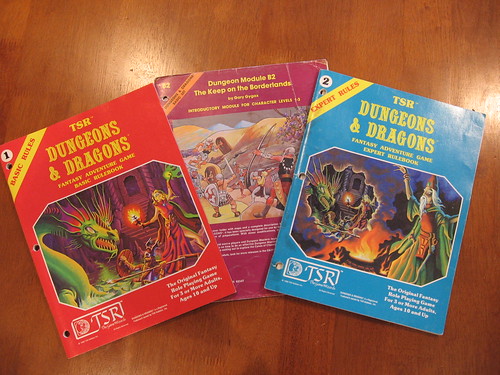It was in the summer of '94 or '95 at DragonCon that I came across a table in the dealer room on which was spread out one of the most beautiful fantasy maps I had ever seen. Curious, I took a step over and struck up a conversation. Ten minutes later, I walked off with a box containing the map (in two halves) and two small booklets that I have poured over ever since.
Here, creatures of dark evil roam the lands in search of prey, while others rule a terrified populace from the safety of their throne rooms. Meanwhile, elven warriors battle expansionist human kingdoms to protect their forest homes, dwarven rebels plot the overthrow of their human conquerors, and the armies of hobgoblin kingdoms grow increasingly powerful.I didn't start a campaign in Kalamar at that time, mostly because I was already involved in a long-standing homebrew. I did however find quite a few pieces of inspiration in the Kingdoms that I stole for my world and happily bought the 3rd Edition D&D books when they came out.
Spies and spellcasters seek knowledge and power for themselves and those they serve, and strands of their web-like plots reach into cities and towns across the continent. Ruins of ancient empires lie buried beneath burning desert sands, and their stories told in smoky back rooms attract brave fools eager for excitement and quick wealth. The streets are full of the brave and foolhardy, eager to draw steel and strike for little cause, and war between kingdoms is a constant occurrence. The courts of the nobility also hold mystery and intrigue, provided one can master social pressures greater than the threat of a giant’s club or a dragon’s fang.
All this and more awaits you in the Kingdoms of Kalamar, for use with Dungeons & Dragons® and other fantasy gaming systems. (From Kenzerco's website)
Now, I can understand why a lot of people dismiss the setting as "vanilla." It's actually designed that way in the vein of Greyhawk and the Forgotten Realms: A world where the DM (GM) can drop in just about anything, set his characters up in just about any Western to Near-Eastern culture, and be ready to go. That is not, in my mind, necessarily a bad thing. After all, D&D is itself a very Western to Near-Eastern game, tapping into the collective legends and archetypes of this part of the world (including, interestingly, the American archetype of the savage frontier). A "vanilla" setting is just a way for the DM to jump past the large-scale world design and into the small-scale adventure and mid-scale campaign design.
However, even the vanilla settings had their own niches and flavors. Greyhawk was a pseudo-Medieval Europe (including knights and a bazillion types of pole-arms) but with pockets of ruins and lost civilizations, free cities of intrigue, and monsters that gave the edges of civilization a definite sword-and-sorcery vibe. The Forgotten Realms, on the other hand, had a very high-fantasy, Tokienish feel, with names that would have been at home in Sindarin, a Northland of scattered city-states separated by leagues upon leagues of untamed wilderness, and numerous evil domains that required strong heroes to hold them back, even for a time. (I'm leaving out Dragonlance for now because it's niche was mostly its meta-plot and the ability of the players to run through it.)
So what is Kalamar's niche? In a word, it feels real.
The setting's strength was that it was at its core a low-magic or at least rare-magic world. There were certainly powerful wizards about, but the fairly deep history provided only gave a handful of instances where events turned on some wizard's magic (such as the elven king cursing the King of Brandobia with fertility, resulting in triplets tearing the kingdom apart). For the most part, kingdoms rise and fall by the sword, not by the spell, the underlying philosophy being that it's easier for a DM to add magic to a setting than to take it away. Therefore, the geography and history, though of course vastly different than earth's, are kept deliberately "realistic," giving one a good base from which to extrapolate additional history and future events. Magic is very much a part of the setting, but is kept subtle enough in the core material that the GM has plenty of room to add it, without having to remove any core elements like airships, wizards' conclaves, or world-shaking cataclysms if he doesn't want them in there.
 |
| I have to admit, I really loved this setting. |
Sadly, despite the lack of meta-plot, there were some changes (or at least some development directions) that were forced upon the Kingdoms of Kalamar when it became an official setting for 3rd Edition. The necessary "crunch" quota for a 3rd Edition setting (races, classes, prestige classes, feats, etc.) took KoK in some directions that I never felt really suited it. By attempting to make the setting fit with 3e's assumptions, the world lost much of its rare-magic charm, a subject that I'll return to in a future post.
So why return to Kalamar? Well, that's another post in the making.


